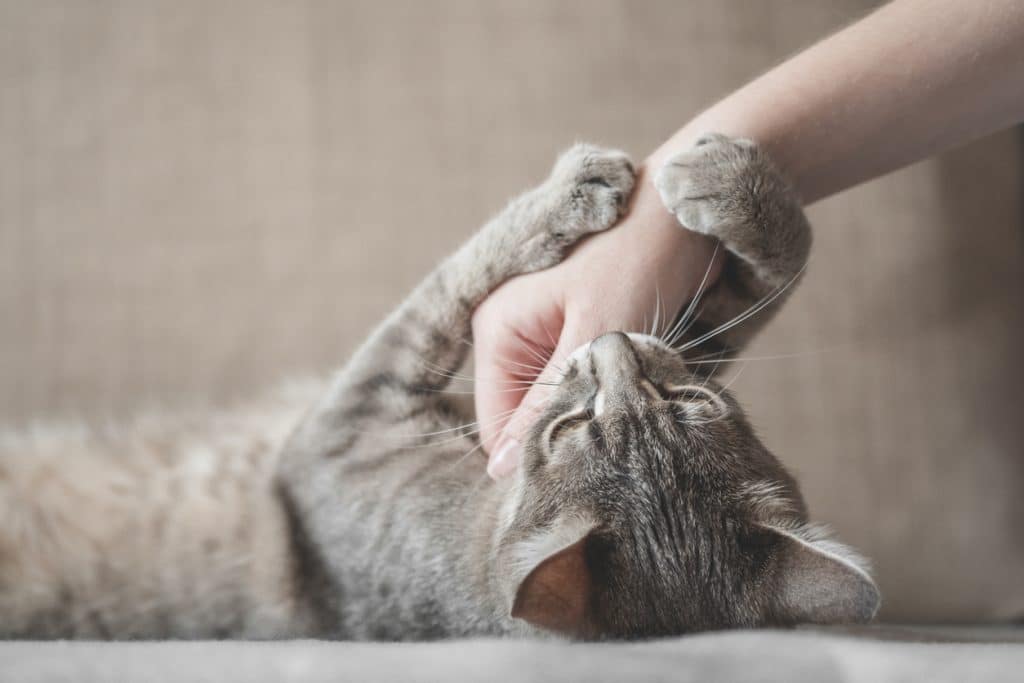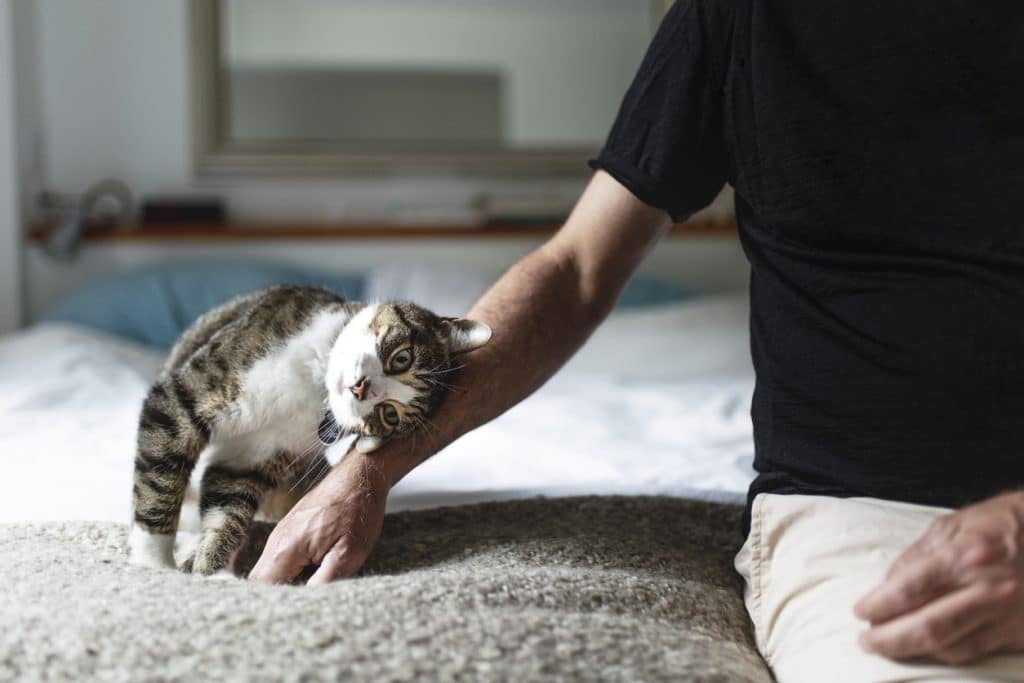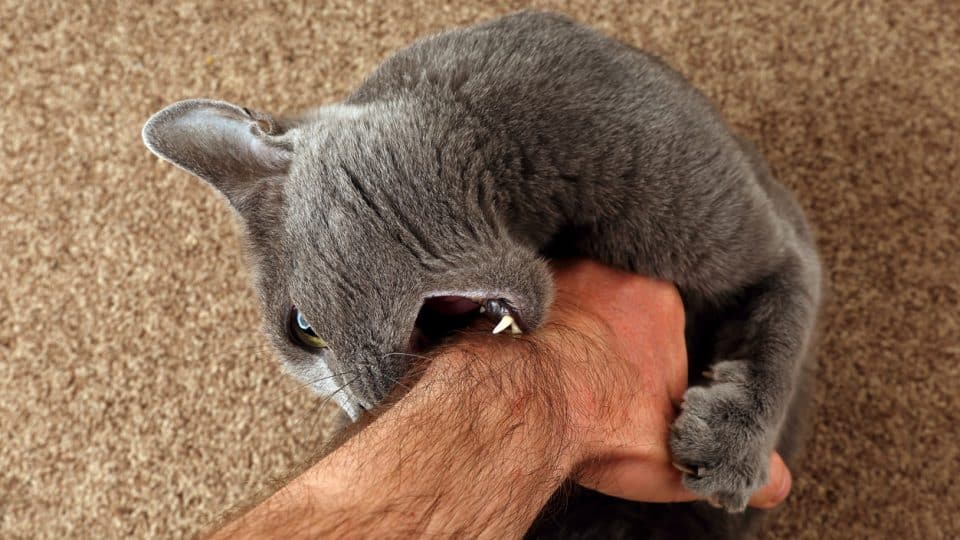- Not a substitute for professional veterinary help.
Cats are sensitive creatures, especially when it comes to being touched. A petting session that runs a minute too long can end with an unexpected nip or swat. A play session that gets too rowdy could also lead to a cat attacking your hands and feet. In other words, overstimulation aggression is when your cat experiences sensory overload and tells you to stop what you’re doing with a surprise bite.
No, your cat isn’t being rude or spiteful. They are just reacting to an overload of stimulation. Your cat has many receptors on their skin that can make repetitive petting or playing a lot. A cat in pain may also react negatively as petting leaves them feeling vulnerable.
Every cat’s sensitivity threshold will vary. Some can handle longer periods of petting; others will feel uncomfortable after a minutes. Thankfully, you can easily spot an overstimulated cat by looking for classic signs of discomfort. When you suspect or see signs of overstimulation, slowly get up and give your cat space to decompress.
Read on to learn all the signs of overstimulation and how to calm your cat after, to make amends for over-petting them.
11 Ways to Tell If Your Cat Is Overstimulated
These warning signs are a good reason to not approach your cat or back off from petting them. To reduce stimulation, avoid petting your cat from head-to-tail, keeping touches light and to the head, cheek, or neck only.
- Tail whipping: When the pace and force of a cat’s tail movement escalates to tail lashing or flicking, your cat is showing signs of agitation. A relaxed cat will casually swing their tail from side to side.
- Nipping or biting: Most cat owners have experienced what we’ll call “love bites” . A sudden nip could mean your cat has reached her petting limit.
- Paw swatting: Paw swatting is pretty indicative of a frustrated animal.
- Growling or hissing: Cats will also vocalize when they’re feeling antsy. In this context, a low growl translates roughly to: “I’ve had enough! Please. Stop.”
- Cessation of purring: A happy hum usually means your cat approves of the massage she’s getting. If she stops purring , take it as a sign she’d like a break.
- Dilated pupils: Dilated pupils can be a sign of stress, anxiety, or fear in cats.
- Flattened ears: Our cats’ ears can move independently of each other —a feature that serves them well in the communication department. “Airplane ears”, or ears flattened back against the head, indicate an uneasy cat who’s warning you to back off.
- Crouched position with lowered head: This guarded stance usually means a cat is uncomfortable with what’s going on.
- Muscle tension: A cat sitting in a rigid position might be experiencing a “fight or flight” moment. Look for twitching of the skin along a cat’s back as well.
- Raised hackles: When the hair on a cat’s tail stands on end, it usually means they’re frightened or startled.
- Unsheathed claws: Claws that abruptly come out can be a sign of discomfort.

iStock/Kseniia Soloveva
What Causes Overstimulation in Cats?
1. They reached their sensitivity threshold
Susan Nilson, PCB-A, an animal behavior consultant and founder of The Cat and Dog House, explains that cats have smaller frontal lobes than dogs. “[This] may explain why they are more easily aroused and take longer to recover from negative emotions,” says Nilson.
Typically, the frontal lobe inhibits emotions. A cat’s comparatively smaller frontal lobe might mean they react less efficiently to stimulation than other species, with larger frontal lobes, who may enjoy heavy pets. Cats who are deaf or blind may also have a lower sensory threshold.
Sometimes, overstimulation in cats leads to petting-induced aggression, or overstimulation aggression. This is when we are on the receiving end of a seemingly unprovoked attack while petting our cats. Cats have no control over this response, and it doesn’t mean they dislike you—or the petting, even. It could just mean they’ve passed the point where it feels good.
2. Their predator and prey drive kicks in
Overstimulation is also related to a perceived lack of control. As a rule, cats prefer to be in charge of deciding the duration of petting and how it occurs. Plus, as both predator and prey animals, cats like to stay alert to any potential threats, Nilson tells us.
“Essentially, if cats let themselves get too relaxed when we’re petting them, they can suddenly start to feel vulnerable and exposed,” she says. “So you end up with a cat who’s feeling conflicted. Does she stay and enjoy being petted—or does she do whatever she needs to so she can escape the sudden potential danger?”
3. They are in pain or not used to pets
An aversion to touch could indicate your cat is in pain. A cat with a bad back, for instance, might react negatively when touched in a sensitive area.
Additionally, lack of socialization can be a factor. Cats who receive less human handling as kittens may end up being less comfortable with petting later in life.
How to Calm an Overstimulated Cat
The best way to calm an overstimulated cat is to give your cat space. Keep your movements slow as you walk away or get up, giving your cat plenty of room to move where they please at their own pace. You may need to wait anywhere from a few minutes to an hour for your cat to feel normal again. Do not pick up an overstimulated cat as this can increase aggression.

iStock/filadendron
If your cat is overstimulated and wants to play, you can also redirect them with a toy. You can also try giving your cat a lickable cat treat, as licking is a calming behavior for many pets.
Never punish your cat for aggressive behavior
Your cat doesn’t understand what’s causing their overstimulation, and they can’t control their response to it. If you punish your cat for swatting or reacting to their sensory overload, you risk creating a negative association with human hands. Your cat may end up feeling even more anxious and uncomfortable around being touched.
6 Ways to Prevent Cat Overstimulation
As a rather sensitive soul myself, I can appreciate the discomfort that comes with being overstimulated. The key is to build in predictability and routine so your cat has an appropriate outline for aggression or play. Here are ways to prevent overstimulation and train your cat to enjoy pets.
Keep your touches gentle and short
Use a gentle touch with your fingers and not your whole hand. You can also let your kitty take the lead by offering your hand to see where what part of their body they rub against you.
It’s also smart to watch the clock so you get an idea of how long to pet your cat. A minute of pets is generally stimulating enough for a cat. But if you notice your cat is becoming stiff or alert, or their tail is twitching, before the minute is up, take a break. Avoid pushing your luck.
Get to know your cat’s preferred spots
My own cat, Floyd, is a major fan of chin rubs and full-body strokes—my other kitty, Amber, is all about belly rubs. Every cat is different and will like different ways of being pet, confirms Dr. Patrik Holmboe, head veterinarian for Cooper Pet Care.
“Think about humans you know. One might like shoulder rubs, another might like a back rub for a few minutes, but not for much longer,” he says. “Cats are the same—but they can’t talk to us! So you need to read their non-verbal signs instead.”
Some cats may not enjoy being cuddled at all. In this scenario, you may have to find alternative ways to engage your cat, rather than forcing them to accept your pets.

iStock/Linda Raymond
Learn your cat’s body language
Our cats can’t talk, but they can certainly show affection in their own way. And if you pay attention, your cat will let you know what kinds of touch they prefer through their eyes and purrs.
“Preventing overstimulation comes down to two things: knowing what your cat likes (which comes with paying attention to your cat over time) and reading the signs of your cat in the moment,” points out Dr. Holmboe.
Body language and behavior have a lot to do with it. “If you’re rubbing your cat’s belly and she’s purring, closing her eyes, and twitching her feet—she’s probably enjoying it!” Holmboe explains.
Avoid using your hands and feet as toys
Cats can also become overstimulated during play, triggering an attack on unsuspecting hands or feet. Even if it’s painless, using your hands and feet as toys should be avoided because it can develop into a bad habit. Your cat may start to regularly attack your hands and feet in effort to start play.
Instead of waving your hands in front of your cat to play with, offer plenty of cat toys as a stimulating outlet.
Dedicate play time and solo play time
A bored cat spells trouble if boredom leads to frustration or destructive behavior. Signs of a bored cat include overeating, fighting, and getting into mischief. To redirect your cat’s energy, schedule play time every day. Wand and lure toys are good toys for cooperative play.
If you want your cat to play by themselves, try cat puzzle toys.
Treat your cat after every pet
Also known as counter-conditioning, treats can help your cat learn to love being pet. What you need to do is dedicate time every day to petting and treating your cat. After each pet, give your furry friend a high value cat treat. This method of positive reinforcement is like putting money in the bank — overtime the association of good things (treats) will accumulate, and your cat will start to look forward to being pet.
Keep in mind that, for a while, your cat may only accept pets in exchange for treats. There is a chance your cat will get upset if you pet them and don’t have a reward!
Bottom Line: Learn Your Cat’s Boundaries
If your cat swats and rejects your touch, you will want to start with building trust and positive reinforcement. Trust starts with respecting a cat’s boundaries and ability to consent to being touched. If your cat likes touches — but has a tendency to snap — then keep touches short and make a point to avoid areas they don’t like.
Petting-induced aggression isn’t to say your cat doesn’t love you. They still want (and need) your attention and affection but prefer to have it on their terms, in the right amount and at the right intensity. By letting your cat dictate when and how they are touched, the more likely they’ll accept pets from you in the future.
If you’re struggling to interpret your cat’s body language, Dr. Holmboe offers reassurance. “Cat parents shouldn’t expect to know everything right away. Take the time and care to learn how each cat communicates in their own way.”
Once you master your cat’s unique love language, you’ll be better able to gauge their petting preferences—an important part of fostering a healthy and safe relationship with your special friend.


